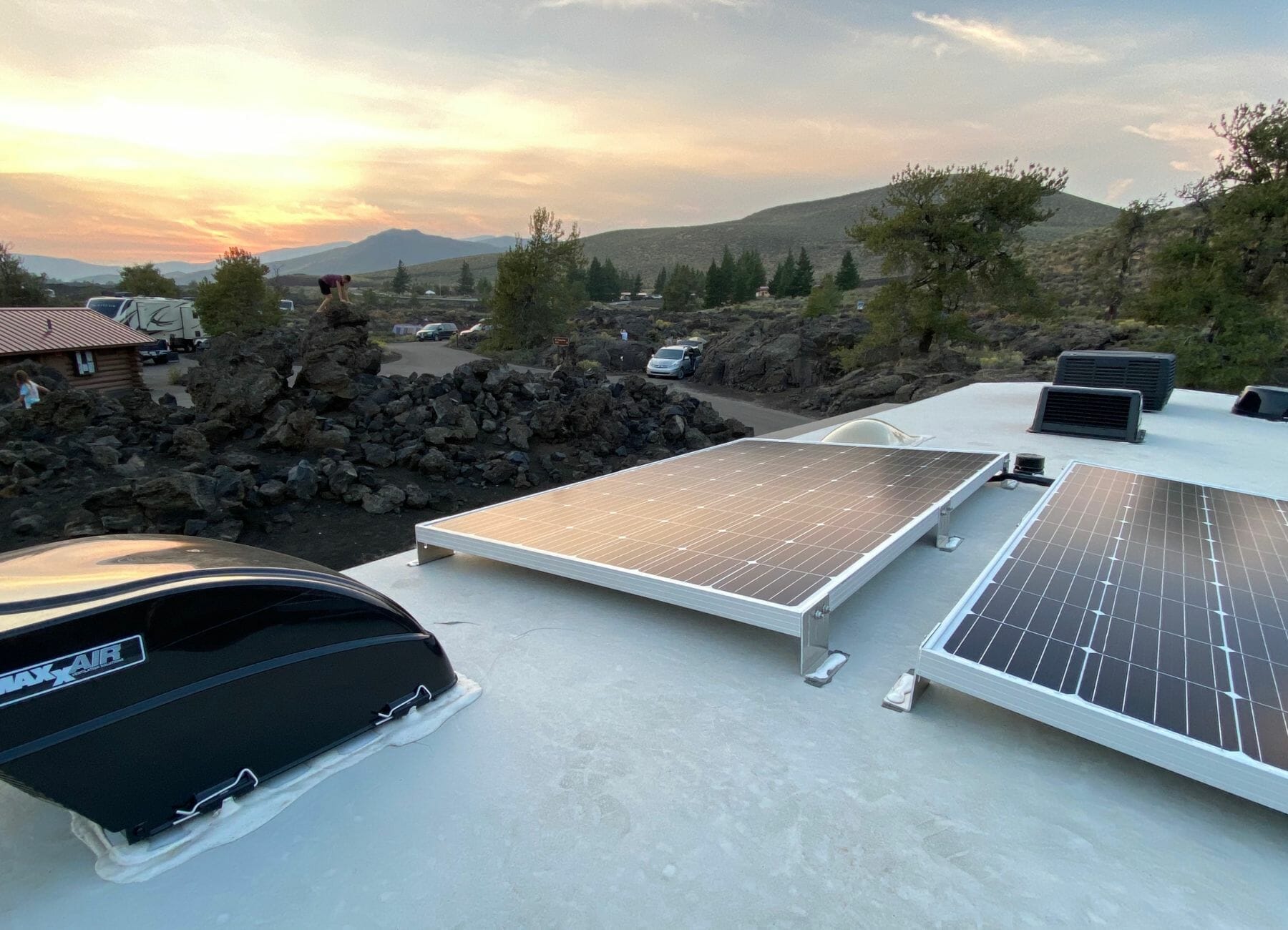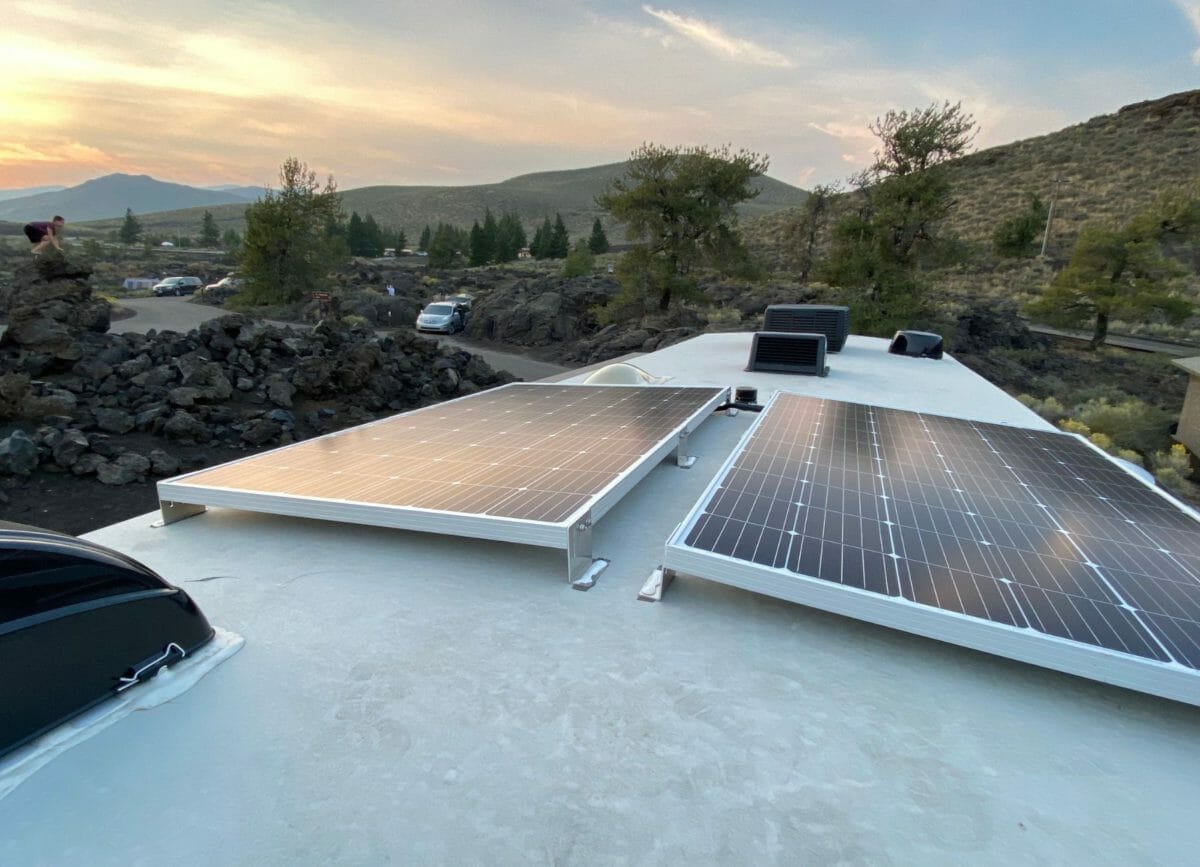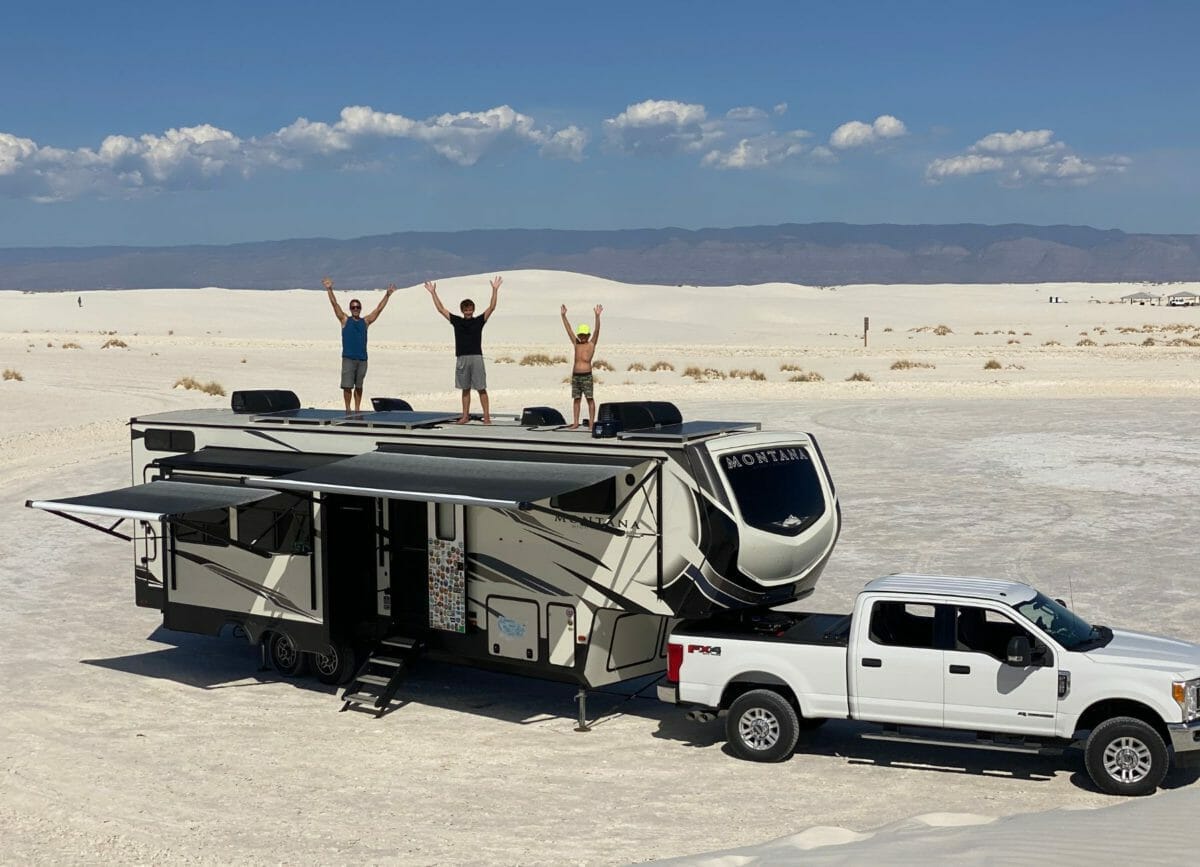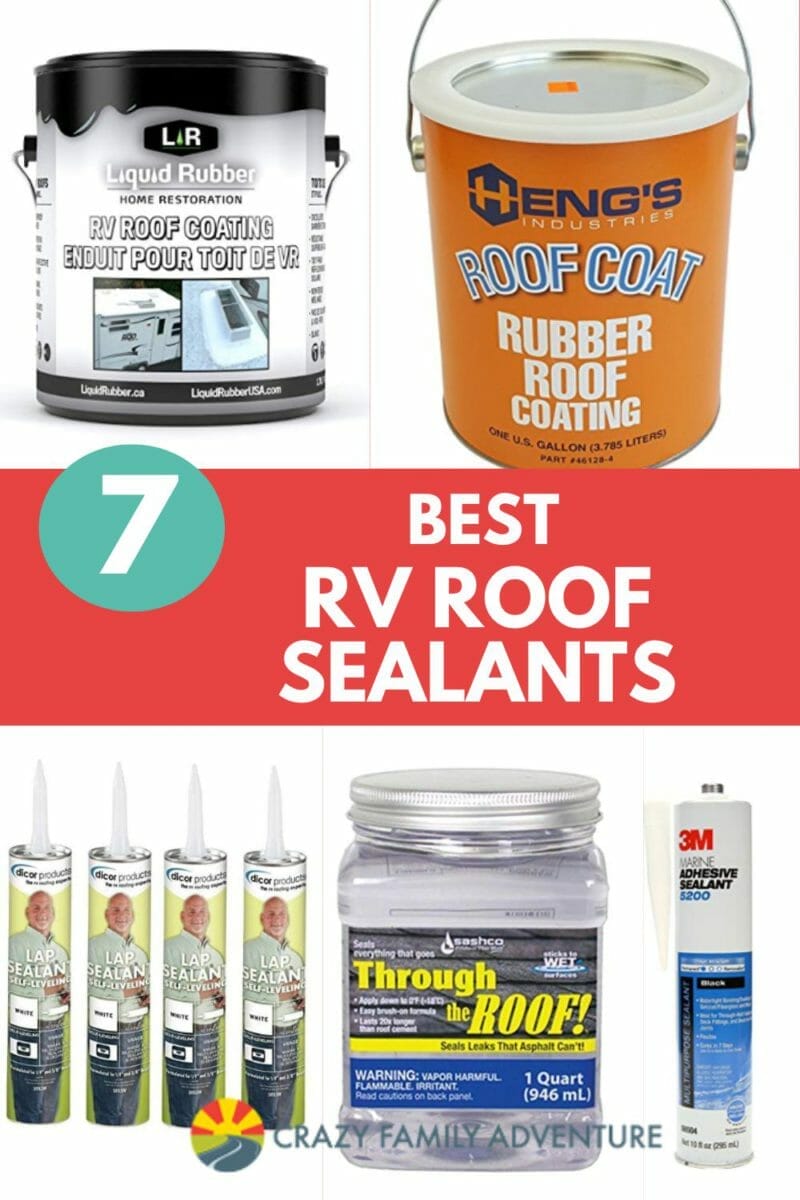It is important to know what the best RV roof sealant is to protect your RV from leaks and water damage. Plus to extend the life of your RV roof.

We lived full time in our RV for 8 years so we have some experience! Below we share our top picks for RV roof sealant and details on each. Including, why we picked these. Plus tips on what to look for when selecting your RV roof sealant. If you are living in your RV or just planning an RV trip it is important to make sure your RV roof is good to go!
Table of Contents
Top RV Roof Sealants
- Top Pick: Dicor Self-Leveling Lap Sealant
- Best Liquid Option: Liquid Rubber RV Roof Coating
- Tape Option: Eternabond RoofSeal
Why Do You Need RV Roof Sealant?
Most RV roofs are made via a truss system. The truss system is several pieces of wood that are glued, stapled, and gusseted together with metal brackets to make a rafter. This approach is cheaper than real wood and also lighter. Which keeps the RV weight as low as possible.
This is a major design requirement for RV’s. And is why RV manufacturers try to build an RV roof with a specific roof material as inexpensively and as light as possible.
Due to how the roof is constructed. Plus the nature of RV travel causing continuous stress on the RV unit, ongoing roof inspection, and regular repairs are necessary.
The roof protects the entire unit, and a roof leak can destroy the entire RV with water damage, mold, and deterioration.
Vibration and travel stress can cause shifting of the RV frame. Extreme weather conditions (think Arizona heat, Oregon rains, Florida salt breeze, or Minnesota sub-zero temps) can damage the initial factory sealant on the roof seams. Either by UV rays damaging the composition of the sealant (why UV-resistant sealant is good to have) or by temperature fluctuations causing it to expand and contract over time.
AC unit and vents are also sealed with RV roof sealant, which dries and cracks over time.
New RV Owners
New RV owners are not always informed about the required regular roof maintenance at the time of purchase. RV manuals do share ways to protect your RV (but who reads those :)). Many RV manufacturers might even void their warranty if regular maintenance is not performed. It is the RV owner’s responsibility to check the roof regularly for the condition of the seams and sealant.
Seeing RV roof issues can be challenging. Unless a leak presents itself. However, RV owners should show do their due diligence. Being proactive in their RV roof care. Just like one has to attend to home improvement tasks when you are a homeowner. RV maintenance is much the same.
RV Roof Sealant Options

There are several different options when it comes to RV roof types of sealant. Let’s take a closer look at each:
- Initial factory sealant
- Post-market reapplication products
- Liquid
- Tape
- Permanent coating
- Unconventional make-shift camper roof covers (not a true RV roof sealant)
Overall cost, ease of application, the type of RV roof, and general use of RV are all factors that contribute to the choice of RV sealant used.
As more and more individuals enter the RV market, especially full-time, more customers are looking at ways to streamline RV roof resealing to avoid loss of RV use due to repairs or water damage. With individuals treating their RV as a home, a long-term solution is often more lucrative, and options like Roof Armor are a great alternative to ensure the roof is sealed properly for the long haul.
By taking a closer look at each option, one can better decide which choice is best for their personal situation.
Initial factory sealant
When purchasing a brand-new RV, the roof is usually sealed with one of three major options:
- Standard EPDM/TPO/Vinyl
- Standard Fiberglass
- AcryPro RV Roof System (or similar option)
The Standard EPDM/TPO/Vinyl is about $10,000-18,000 of the overall unit cost. It needs frequent maintenance and resealing. Must go to the installer to get repaired (with long wait times). Has a 10-year limited warranty. And eventually will need to be replaced. This EPDM roof consists of EPDM rubber, which is an extremely durable synthetic rubber roofing membrane (ethylene propylene diene terpolymer).
The Standard Fiberglass is about $11,500-20,000 of the overall unit cost. Needs frequent maintenance and resealing. Must go to the installer to get repaired (with long wait times). Has a 10-year limited warranty. Must eventually be replaced. (Source)
The AcryPro RV Roof System has no replacement, no maintenance, lifetime material, and labor warranty. It is installed where you are. It is the last RV roof you will ever need.
The hard-top options like AcryPro or Roof Armor are usually custom after-market add-ons, not standard manufacturer’s options.
Post-market reapplication products
The post-market reapplication products fall into three main categories. Liquid, tape, or permanent coating (which, to be fair, is only applied once after the unit leaves the manufacturer).
Self-leveling sealant (like Dicor products). Are applied similarly to a thick silicone or caulk or weather-proof seal tape like Eternabond for a flex seal.
Liquid sealants come in caulking tubes. While others come in 1-gallon buckets when coating 1 gallon of surface is all that’s needed.
The permanent sealant comes in 1-5 gallon buckets to allow for a coating of the entire roof. Creating a liquid rubber RV roof coating. The coating will last for the entire life of the RV. Similar to the roofs of mobile homes.
Customers tend to lean toward a solution that offers an easy application and doesn’t break the bank in the process.
Unconventional make-shift camper roof covers (not a true RV roof sealant)
This third method is hardly an RV roof sealant. However, it should be mentioned since many individuals choose this method to protect their RV roof, until they can take care of their roof leaks. This is either to strap down a tarp over the roof. Use duct tape, or park the RV under an awning/carport. All of these options are temporary and are not considered true repairs to the RV roof.
Top Things To Consider When Looking For RV Roof Sealant
- Quality/Longevity
- Cost
- Ease Of Application
- Brand
- Reviews
- Long-term VS short-term RV Roof Sealant
The initial RV roof inspection should happen prior to taking ownership. Even new RV units can start having roof issues. Especially if the quality control standards of the manufacturer are sub-par.
The RV manual states to check the roof every six months and to reseal annually. Take note: You should adjust this timeline based on where you live and the wear and tear your roof takes.
If there was a storm or your RV sat uncovered in 130F sun for a week or two, events like this are great opportunities to check on the roof condition and to examine the sealant seams to avoid future roof leaks or roof repairs.
7 Top Recommended RV Roof Sealants

Below are the current Top 7 recommended RV roof sealants, according to market research, customer feedback, and RV “veteran” recommendations.
- Dicor Self-Leveling Lap Sealant
- Eternabond RSW-4-50 Roofseal Sealant Tape
- Geocel ProFlex RV Sealant
- Sashco Through The Roof Sealant
- 3M Marine Adhesive Sealant 5200
- Beech Lane RV Permanent Repair Tape
- Heng’s Rubber Roof Coating
- Liquid Rubber Leak Repair Sealant
Top Pick
Hands down, Dicor Self-Leveling Lap Sealant, wins the Top Pick for RV roof repairs. Used by RV service centers US-wide, this self-leveling sealant does the job, is cost-effective, and seals up all the nooks and cracks. It is weather-resistant and dries fairly quickly.
- Creates a secure, secondary seal along the roof’s edges, air vents, vent pipes and screw heads
- Adheres firmly to aluminum, mortar, wood, vinyl, galvanized metal, fiberglass and concrete
Best Liquid Option
Liquid Rubber RV Roof Coating takes first place in this category. Easy to apply, great coverage, and solid performance when it comes to sealing the RV roof to waterproof it.
- FLEXIBLE WATERPROOF MEMBRANE: Our professional-grade RV roof sealant creates a flexible seal,…
- COMPLETE ROOF PROTECTION SYSTEM: This elastomeric roof coating with heat reflective properties…
Best Tape Option
Eternabond RV Roof Repair MicroSealant UV Stable Roof Seam Repair Tape, for waterproof and airtight repair, as it doesn’t only fix roof leaks and close up seams but also seals any small holes in the external RV walls to protect from the weather. This tape is strong!
- MULTI-USE: Perfect for use on metal buildings, trailer/RV roofs and sides, drain pans, drain pipes,…
- NO ADDITIONAL SEALING REQUIRED: Aluminum backing, combined with a layer of advanced MicroSealant,…
Dicor Self-Leveling Lap Sealant
- Creates a secure, secondary seal along the roof’s edges, air vents, vent pipes and screw heads
- Adheres firmly to aluminum, mortar, wood, vinyl, galvanized metal, fiberglass and concrete
Features:
- Dries fast
- Fairly cost-effective
- Weather-proof
- Self-leveling (minimizes messes)
Application: After the roof examination, scrape off the old sealant and wash the surface of the roof. Use Dicor to reseal any exposed seams or cracks. Cut off the tip of the sealant tube and use a caulking gun to apply beads of the sealant to the area. Since the material is self-leveling, there’s no need to spread it.
This works great on Standard EPDM/(most)TPO/Vinyl and Standard Fiberglass roofs where seams need to be resealed.
The consistency is that of a thicker silicone, and it comes in a silicone tube application. You will need an Exacto knife to cut open the tip of the tube and a caulking gun to use the sealant. For any mess wipe-up, have some baby wipes or a rag ready.
Pros:
- Cost-effective
- Easy to use
- self-leveling
Cons:
- Old sealant might be a bit tricky to remove
Eternabond Roofseal
- MULTI-USE: Perfect for use on metal buildings, trailer/RV roofs and sides, drain pans, drain pipes,…
- NO ADDITIONAL SEALING REQUIRED: Aluminum backing, combined with a layer of advanced MicroSealant,…
Features:
- Easy to store
- Versatile application
- Weather-proof
Application: After the roof examination, scrape off the old sealant and wash the surface of the roof. Use Eternabond to reseal any exposed seams or cracks. It can be a bit challenging to try to apply the tape evenly and then try to cut the section off the roll.
This works great on Standard EPDM/(most)TPO/Vinyl and Standard Fiberglass roofs where seams need to be resealed.
The tape is really thick and sticky. You can use an Exacto knife to carefully cut off the section from the roll.
Pros:
- Great seal
- Easy to use
Cons:
- The initial cost might be a bit high (you must purchase a whole roll)
- Unforgiving (it really sticks, even if you make a mistake)
Geocel ProFlex RV Sealant
- Crack resistant
- Exceptional flexibility
Features:
- Great sealant bond
- Weather-proof
- Easy application
Application: After the roof examination, scrape off the old sealant and wash the surface of the roof. Use Geocell to reseal any exposed seams or cracks. This sealant is a competitor to Dicor and comes in clear or white colors.
This works great on Standard EPDM/(most)TPO/Vinyl and Standard Fiberglass roofs where seams need to be resealed.
The sealant sets up quickly, dries fast, and remains flexible so that it does not warp and crack during travel.
Pros:
- Great sealant
- Easy to use
Cons:
- A bit challenging to use with a caulking gun
- Sets too fast (don’t apply more than 2 ft at a time)
Sashco Quart Clear Roof Sealant
- Elastic – flexes with temperature changes and wind
- Ultra-clear and stays clear – will not yellow over time
Features:
- Lasts 20 times longer than roof cement
- Tolerant to extreme temperatures
- Does not crack or go brittle
Application: After the roof examination, scrape off the old sealant and wash the surface of the roof. Use Sashco to reseal any exposed seams or cracks. The sealant comes in several colors, most commonly used in clear or black (on asphalt shingle roof repairs).
This works great on Standard EPDM/(most)TPO/Vinyl and Standard Fiberglass roofs where seams need to be resealed.
Use a paintbrush or a roller to apply the sealant and let it dry. The sealant can be painted over with latex paint 24 hrs after application, and it adheres to galvanized metal, aluminum flashing, copper, PVC, ABS, neoprene, plastic, brick, block, mortar, concrete, cement board, acrylic, asphalt, wood, steel, painted surfaces, etc.
Pros:
- Great seal
- Easy to use
- Permanent
Cons:
- The initial cost might be a bit high
- Unforgiving (dries fast, difficult to clean up mistakes)
3M Marine Adhesive Sealant 5200
- MULTI-SURFACE SEALANT: A permanent solution for bonding marine substrates like wood, fiberglass, and…
- VERSATILE APPLICATIONS: Tough yet flexible polyurethane polymer is ideal for deck housings, hull…
Features:
- Easy application
- Brand recognition
- Broad application (RV and marine, assuring 100% waterproofness)
Application: After the roof examination, scrape off the old sealant and wash the surface of the roof. Use 3M Marine Adhesive Sealant to reseal any exposed seams or cracks.
This works great on Standard EPDM/(most)TPO/Vinyl and Standard Fiberglass roofs where seams need to be resealed.
Use an Exacto knife to cut the tip of the sealant and use a caulking gun to apply the sealant.
Pros:
- Great seal
- Easy to use
- Seals even against salt water
Cons:
- Pricier than other brands
- One week cure time
Beech Lane RV Permanent Repair Tape
Features:
- Easy to store
- Versatile application
- Great sealant bond
Application: after the roof examination, scrape off the old sealant and wash the surface of the roof. Use the Beech Lane RV Tape to reseal any exposed seams or cracks. It can be a bit challenging to try to apply the tape evenly and then try to cut the section off the roll. This tape is a competitor to Eternabond.
This works great on Standard EPDM/(most)TPO/Vinyl and Standard Fiberglass roofs where seams need to be resealed.
The tape is really thick and sticky. You can use an Exacto knife to carefully cut off the section from the roll.
Pros:
- Great seal.
- Easy to use.
- It is much cheaper than Eternabond.
Cons:
- Unforgiving (it really sticks, even if you make a mistake).
Heng’s Rubber Roof Coating
- Designed for use over RV rubber roofs, at seams and tears and to seal vents, air conditioners, etc.
- It is UV resistant and expands and contracts with roofs
Features:
- Great sealant bond
- Weather-proof
- Easy application
- Comes in 1 quart or 1 gallon
Application: after the roof examination, scrape off the old sealant and wash the surface of the roof. Use Heng’s to reseal any exposed seams or cracks.
This works great on Standard EPDM/(most)TPO/Vinyl and Standard Fiberglass roofs where seams need to be resealed.
Use a brush or a roller to apply the sealant to the roof areas that need to be resealed and covered.
Pros:
- Great seal.
- Easy to use.
Cons:
- A bit pricey.
- It can get messy during application.
Liquid Rubber Leak Repair Sealant
- FLEXIBLE WATERPROOF MEMBRANE: Our professional-grade RV roof sealant creates a flexible seal,…
- COMPLETE ROOF PROTECTION SYSTEM: This elastomeric roof coating with heat reflective properties…
Features:
- Solar reflective
- Weather-proof
- Easy application
- Available in 1 gal or 5 gal buckets
Application process: after the roof examination, scrape off the old sealant and wash the surface of the roof. Use Liquid Rubber to reseal any exposed seams or cracks. You can apply this on the entire roof to create a permanent shell coating.
This works great on Standard EPDM/(most)TPO/Vinyl and Standard Fiberglass roofs where seams need to be resealed or for roof coat.
Use a brush or a roller to apply Liquid Rubber evenly onto the roof.
Pros:
- Great seal
- Easy to use
Cons:
- Pricey
- Messy
There you have it from roof types to maintenance, these are the 7 RV roof sealants we recommend! No matter what be sure to stay on top of your RV roof maintenance so you don’t end up with a huge problem with your RV.
Note: We are a participant in the Amazon Affiliate Program, which is at zero cost to you.
Check Out Our RV Remodel
Learn More about Great RV Remodel Upgrades
31 Amazing RV Upgrades You Can’t Live Without
9 Outstanding RV Stabilizers for an Unshakeable Experience
Fun and Simple Remodel Ideas for Your 5th Wheel
6 MORryde Products You Need For Your Rig
Save to Your RV Pinterest Board

- 31 Amazing RV Upgrades You Can’t Live Without - July 9, 2024
- 8 Breathtaking THINGS TO DO Near Yellowstone National Park - May 22, 2024
- Utah National Parks Road Trip: All 5 Parks & More [Map Included] - May 11, 2024
DISCLOSURE: This post may contain affiliate links, meaning I get a commission if you decide to make a purchase through my links, at no cost to you. Please read my disclosure for more info.








